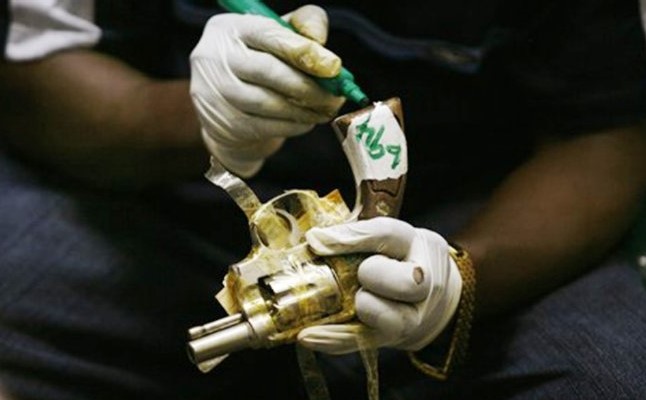Ricardo Arduengo/AP
By
Ricardo Swire
The rise of Caribbean crime is characterized by use of more powerful weapons, resulting in higher mortality levels. The illegal guns and drugs trades form a symbiotic relationship, a dualism that has caused an increased display of violent aggression throughout Caribbean communities.
In the past, on many English speaking islands, the majority of assaults and murders were committed with blunt or sharp edged weapons. In the 1970s commission of crimes using guns began in Jamaica, Trinidad & Tobago (T&T) following in 2000. By May 2006 T&T’s percentage ballooned to seventy-four percent. Internal Security data indicates that licensed T&T firearm users owning legal guns are robbed, sometimes killed, for their weapons. At times T&T Defence Force and Police Service guns mysteriously disappear. Weapons stored at T&T police stations for safe-keeping, especially guns with deceased owners, become lucrative diversions to the local underworld.
In 2004 T&T Police Service (TTPS) launched the Organized Crime, Narcotics & Firearms Bureau (OCBFB), a special unit additionally armed with the national Firearms Act. Members report directly to the Twin Island Republic’s Commissioner of Police. The top law enforcement officer, or his representative, is required to record serial numbers of T&T’s legitimate guns in a national “Firearms Register.” Despite the OCBFB’s 2015 record confiscation of six hundred and ninety-one illegal guns that year, similar weaponry continue to fuel T&T’s drugs trade, gang wars and murder rate.
A US Bureau of Alcohol, Tobacco, Firearms & Explosives (ATF) special supervisory agent assigned to Tampa, Florida explained; “You can take a US$200 or US$300 firearm to a Caribbean or South American country and get three, four times the cost. You can sell them for US$900 to US$1,200.” Independent analysis verifies that apart from the USA several of the Caribbean’s smuggled guns are sourced from South and Central American trademarked light arms manufacturers.
Brazil is a legitimate maker of Beretta, Colt and Taurus labels. Venezuela has its official patent from Smith & Wesson. Such firearms are supposed to be ostensibly for domestic licensed private owners and export to foreign government entities. But they are also smuggled to T&T via Venezuela, Suriname and Guyana. Only fifteen kilometers of water and the Bocas Del Dragon Straits separate T&T’s southern peninsula from Venezuela’s north coast.
Security observers are concerned that this country’s ongoing economic, political and social chaos, which led to the novel “Food for Guns” trade, could spiral. Guns are preferred exchange commodity in the drugs trade because a firearm’s standard features cannot be faked. A compromised Venezuelan Guardia Nacional supply of high-powered Chinese imitation Kalashnikovs, Russian AK-103 assault rifles and Dragunov sniper rifles, would be a welcomed booty for T&T’s criminals.
On September 13th 2011 T&T’s National Security Council widened active curfew areas in an attempt to rein in the gun and drug traffickers. Three hundred and sixty-two kilometers of coastline was added. Modification extended three nautical miles offshore. The government assigned one platoon of Regiment personnel to conduct land patrols. Point Fortin the starting point, ending at Cedros. Seaward twenty-six Coast Guardsmen supported this manoeuvre.
Venezuelan government officials publicly recite that rogue military staff are the perpetrators, who steal grenades and military surplus from their headquarters magazine. 2015 recorded forty-seven Venezuelan civilians killed by exploded grenades. Eighty-four residents were wounded. T&T gang members already master the operational mechanisms of comparable Venezuela sourced guns. Kalashnikov variants are in use on T&T.
The AK-103’s 7.62mm high velocity ammunition is interchangeable with AK-47 alternatives that flood T&T gang areas. OCBFB intelligence data noted that guns for cocaine exchanges occur in proximity to T&T’s outer constellation, mainly Cedros, Icacos and Bocas islands. Several isolated beaches serve as clandestine drop off points. Approximately three hundred local fishing pirogues also navigate the waters, conditions that make security a difficult and more dangerous task.



No Comments Yet!
You can be first to comment this post!